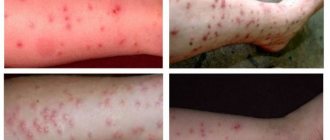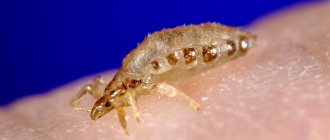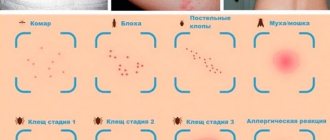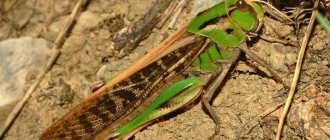Ant bite: how to recognize and why it is dangerous
Ants move quickly once they land on a person’s body, and the places where they bite resemble a “path.” Most often, these marks occur on the legs, arms and pelvic area.
An ant bite may cause blisters and redness.
When bitten, a poison based on formic acid enters the bloodstream. If you compare the pain sensations, ants bite like mosquitoes.
First there is a burning sensation, then the bite site becomes red and swollen. The tumor grows up to 5 cm, and a red spot appears in the center. After some time, small blisters and white pustules appear. Painful symptoms usually disappear within 24 hours; much less often, itching and redness last for 3-4 days.
What happens when an ant bites you?
The bite of even a non-poisonous ant can ruin your mood. The ant body contains a sufficient amount of acid for self-defense, a microdose of which is injected under the human skin when bitten. Externally, the site of an ant bite is similar to a mosquito bite, only the redness is much larger. Also, similarly to mosquito bites, itching and irritation may occur. Sometimes a rash appears (as in the photo) and a local increase in temperature. Symptoms disappear within 3-5 days.
What does an ant bite look like - in the photo there are traces of numerous bites
An allergic reaction is manifested by more severe symptoms: itching all over the body, nausea, arrhythmia, shortness of breath, low blood pressure.
Types of ants that pose a threat to humans
In nature, there are about 12 thousand species of ants, spreading almost throughout the world. But only a few of them pose a threat to humans:
- Nomadic ants (siafu) are found in Africa and South America. Unlike other species, they do not create anthills, but roam in search of food. To reproduce, they build bivouacs (the ants cling to each other with their jaws, forming a ball). Nomadic ants have a frightening appearance: their jaws are larger than their heads, and females reach 5 cm in length. The bites of representatives of this species are the most painful and cause severe allergic reactions.
- The bullet ant is a species of large ant native to the southern African continent. They got their name because of the unbearable pain when bitten, comparable to the effect of a gunshot wound. Insect venom contains the most powerful toxin in nature - poneratoxin.
- The bulldog ant is common in Australia and Tasmania. An encounter with this insect may not cause concern due to its small size (no more than 2 cm), but bulldog ant bites are extremely dangerous and cause an acute reaction, including anaphylactic shock. The venom of representatives of this species is similar in composition to bee and aspen.
- The red fire ant easily adapts to any environment, thanks to which it quickly spread throughout America and its adjacent territories. The venom of these insects contains solenopsin, which has dermatonecrotic, cyto- and neurotoxic effects. Unlike their relatives, red ants sting rather than bite with their jaws. The pain from a bite is comparable to a burn, and the reaction is immediate and severe.
- Forest red ants. We can meet these insects in our forests, fields and city parks. The red ant reaches 1 cm in length, its body is black with a red head and chest. The bite is quite painful.
It is important to know that most often ants attack a person for a reason, but to protect their home. Therefore, when in nature, try to avoid anthills, carefully inspect things left on the ground and shake them off thoroughly. When hiking, it is better to wear long sleeves and closed shoes. If you come across an anthill, try to get away from it and under no circumstances allow children to stir it up, as the ants may respond to this with aggression.
Photo gallery: the most dangerous members of the family
Nomadic ants have a terrifying appearance
The red fire ant adapts well to its environment
Red forest ants live in Russia
The pain of a bullet ant bite is equivalent to the pain of a bullet wound.
The bulldog ant is small in size, but produces a very toxic poison.
Preventive measures against bites
Measures to prevent ant bites are quite simple and even elementary.
Knowing that you have a walk to the habitats of ants, it is enough to follow a few simple rules:
- When going on vacation in nature, in the forest or at the dacha, you should dress appropriately. Clothing should be closed with long sleeves, and shoes should be high and tight-fitting.
- Before settling down at a picnic site, it is better to inspect the area for insects.
- Ants should not be harmed.
- It is better to collect food waste in closed bags so that the ants do not consider it a source of food.
If there are ants in the house, you should immediately exterminate them with insecticides yourself or use the services of sanitation services.
Note! Additionally, you can hide insect repellent herbs around the house, such as mint or lavender (you can use special lavender tablets).
What to do if signs of an allergic reaction appear
The greatest danger to humans is represented by multiple ant bites. An exception is the presence of allergies, where even one damage is enough to develop a severe reaction in the body. The severity of the consequences depends on the state of the immune system and the amount of poison that enters the blood. The location of the bites also plays a significant role - the allergic reaction will be more severe if the bites occur on the neck, face, or chest.
When walking in the forest, beware of anthills
Symptoms of an allergic reaction to ants (redness of the skin, swelling, itching, rash, acute pain) appear in a short time. In more serious cases, general health worsens and the following are observed:
- nausea and vomiting;
- dizziness;
- weakness;
- fever;
- asphyxia (suffocation, difficulty breathing, oxygen deprivation);
- chest pain;
- heart rhythm disturbance;
- lowering blood pressure;
- increased body temperature;
- hives (rapid appearance of blisters throughout the body);
- Quincke's edema;
- anaphylactic shock.
If you show signs of an allergy to ant bites, you should turn to the following remedies:
- external preparations that have antiallergic and antipruritic effects (for example, Flucinar or Sinaflan);
- antihistamines (Diphenhydramine, Diazolin);
- folk remedies: applying a compress with vinegar solution or dandelion leaf to the bite site.
Quincke's edema is an acute condition of swelling of the body, which manifests itself a few minutes after contact with the allergen, that is, after the bite itself. First of all, parts of the face swell (lips, eyelids, tip of the nose, cheeks), then this process spreads to the mucous membranes of the eyes, oral cavity, and moves to the larynx and pharynx. There are cases when swelling covers the limbs, chest and abdomen. Along with external changes, internal ones also occur - when swelling affects the larynx and vocal cords, a person experiences a sore throat, difficulty breathing and hoarseness.
The main external manifestation of angioedema is an enlargement of any part of the body.
The most acute and severe type of allergic reaction is anaphylactic shock, as it affects the entire body. Anaphylaxis occurs as follows: a person experiences weakness, anxiety, dizziness, pain in the heart and abdomen, Quincke's edema, urticaria, vomiting and diarrhea. Then blood pressure drops sharply, breathing becomes difficult, tachycardia and loss of consciousness occur.
Anaphylactic shock usually presents as a complex of different symptoms
Important to remember. In case of acute reactions, such as angioedema and anaphylactic shock, do not self-medicate under any circumstances! It is necessary to call an ambulance and provide first aid as quickly as possible; slowness in such matters sometimes leads to death.
Algorithm of action for Quincke's edema and anaphylactic shock:
- After calling an ambulance, try to move the patient away from the ants.
- Apply a tight bandage above the bite site, and apply a cold compress to the damaged area of skin.
- If you have anaphylaxis, turn your head to the side to prevent the person from choking on vomit.
- Provide fresh air if you are indoors, and be sure to loosen all clothing and remove tight items and jewelry.
- If possible, give an injection of an antihistamine. For Quincke's edema, you can give a tablet by placing it under the tongue. People prone to allergies should always have these medications with them.
- Before the ambulance arrives, be sure to monitor the blood pressure, heartbeat and breathing of the allergic person. If necessary, give him artificial respiration or chest compressions.
According to statistics, 23% of Russians suffer from allergies to insect bites, including ants. 2% of cases of such a reaction are accompanied by angioedema, and at least 77% are accompanied by anaphylactic shock.
Hives are characterized by the appearance of blisters on the skin that merge into large red spots
Hair removal with methanic acid
The compound is used not to get rid of unwanted hair, but to slow down hair growth after the hair removal procedure. Formic acid is used as a powerful antiseptic, only in diluted form. It is added to the oil base or purchased ready-made product immediately. After the first application to the shaved area, oil with formic acid increases the time between epilations, prolonging the effectiveness of the procedure, then with regular use it blocks the activity of the follicle. As a result, hair fiber is not formed and vegetation growth slows down.
Sequence of the procedure:
- remove hair from the problem area (using an epilator, wax, tweezers);
- rinse and dry the skin;
- Apply a thin layer of the product to this area for 15 minutes;
- wash off the oil composition with non-hot water;
- examine the skin area for the presence of an allergic reaction, discomfort (if itching, roughness, or redness occurs, applying oil with formic acid is strictly prohibited; if these phenomena are not observed, the procedure can be continued);
- reapply the product to the selected area for another 15 minutes, gradually the duration can be increased and increased to 4 hours;
- Wash off the oil thoroughly with soapy water.
Repeat this procedure as new hairs grow. To achieve a lasting result, be patient; you will need 7–10 epilations using ant oil. If there are damage to the skin (scratches, abrasions, wounds, cracks), you should refrain from the procedure until they are completely healed. In addition, for safety reasons, it is not recommended to apply the product during pregnancy and lactation.
For more delicate hair removal, 10 drops of ant oil should be added to baby cream; the resulting mixture can be applied daily to problem areas. In addition to slowing down hair growth, you will receive nourishment.
Methods for treating bite sites
If you are attacked by ants, you need to move away from the source of their spread (this could be an anthill or an ant trail) as far as possible and remove the insects from yourself. Once you are safe and have prevented further bites, treat the damaged areas.
Disinfection
First you need to disinfect the area of skin. For this you can use:
- hydrogen peroxide;
- chlorhexidine;
- alcohol solution;
- miramistin;
- soap solution.
Relieving itching and redness
The most well-known remedies that will help relieve itching, pain, redness and swelling are the following:
- cold compress (apply to the bite site for 10 minutes);
- Advantan ointment;
- Psilo-balm;
- Rescuer ointment;
- Fenistil-gel.
Rescuer ointment helps get rid of itching and redness
Antihistamines
You should take medications that block the release of histamine into the blood. This is necessary in order to avoid an acute negative reaction to ant poison. Such drugs are:
- Diazolin;
- Fenistil;
- Telfast;
- Tavegil;
- Suprastin;
- Claritin;
- Zyrtec;
- Loratadine.
The bite site should be treated with a topical agent, for example, Fenistil-gel
Folk remedies
In the absence of medications, you can turn to traditional methods:
- Apply a paste of baking soda and water to the damaged area of skin until completely dry. The procedure must be repeated every 2 hours.
- You can lubricate the bite areas with ammonia, vinegar or mint paste. Many people use Corvalol for these purposes.
- Apply activated carbon pulp to the damaged skin and cover with film.
- Apply raw potatoes or onions, aloe juice, and finely chopped parsley to the red or swollen area.
- Apply tea tree oil to the damaged area until the itching goes away. This remedy not only relieves pain, but also disinfects the wound. You can also use camphor alcohol.
- Rub soft butter into the bite areas several times a day.
- Use herbal decoctions and compresses (mint, plantain, parsley, sea buckthorn, viburnum, birch buds), which have antipruritic and anti-inflammatory effects.
Try not to scratch the bite areas, as this can scratch them and cause infection. There is also a risk of scarring from the wound.
If you apply raw potatoes to the bite sites, the pain will subside and the redness will go away.
Side effects and interactions with alcohol
When treating leather with preparations based on formic acid, be careful and follow the manufacturer's instructions. Since saturated solutions of 10% and higher cause a painful reaction, they are characterized by corrosive properties. Accidental ingestion of such a substance burns the mucous membrane of the esophagus and stomach, and contributes to the appearance of severe necrotic inflammation. The vapors of the chemical compound corrode the tissues of the respiratory organs and cause burns to the cornea of the eyes.
If a concentrated solution of formic acid gets on an area of skin, immediately treat the area with an alkaline solution (baking soda - sodium bicarbonate).
Methane compound and its formaldehyde are metabolites formed during the breakdown of methanol in the human body. These substances are toxic and damage the optic nerve, leading to partial or complete blindness. If methanol enters the body, in order to avoid the formation of formic acid under the influence of alcohol dehydrogenase, you should immediately drink a solution of ethyl alcohol. This way you can prevent a reaction from occurring, the consequence of which is loss of vision.
Ethyl alcohol is a kind of antidote that prevents formic acid poisoning.
Benefits of ant bites
Ants are capable of more than just causing harm. Ant venom contains zinc, enzymes, polypeptides, acids, thanks to which it has many medicinal properties (antioxidant, anti-inflammatory, analgesic, disinfectant, immunostimulating and cleansing). This is why the use of ants is very popular in alternative medicine.
The bites of these insects are used to eliminate symptoms and treat many diseases:
- radiculitis;
- gout;
- pain relief from sprains and fractures;
- varicose veins;
- arthritis and arthrosis;
- atherosclerosis.
Treatment takes place in a course of 10–15 sessions. You need to find an anthill and approach it in your underwear (clothes should be left a few meters away). With the help of a birch broom, the ants are transferred to the body. The main thing is to avoid getting insects on your head, and it is better to plug your ears with cotton wool. After 5 minutes, you should move away from the anthill and shake off the ants with a broom. If you feel better, the duration of the session can be increased to 10–15 minutes. After finishing the procedure, you need to take a shower.
There is another method that is used mainly to treat children. To do this, take a cotton or linen shirt and leave it on the anthill for 30–40 minutes. During this time, the clothes are soaked in formic acid, after which they are carefully cleaned of insects and put on the child. You need to wear it for 3 days.
Before you trust traditional medicine, consult your doctor and make sure that you are not allergic to ant poison. Although treatment with these insect bites is considered effective, it can cause different individual reactions and consequences. This approach should be approached with extreme caution.
The risks of using insect poisons outweigh their benefits. Therefore, in my opinion, you should not use insect poisons for self-medication, so as not to become a victim of hymenopterism - human poisoning due to insect bites and stings.
Elena Lesiovskaya, Doctor of Medical Sciences
https://fismag.ru/pub/les-06–16.php
Formic acid is used in the production of medicines (Muravyvit, formic powder, oil extract). These drugs are effective in the treatment of hepatitis, tuberculosis, kidney failure, impotence, and emphysema.
Application
Methane acid does not belong to the category of vital compounds for the human body. The permissible daily intake of the substance is 3 milligrams. It is well absorbed by the liver, at high concentrations it has a diuretic effect and is excreted in feces.
Formic acid is an activator of chemical reactions in the intercellular matrix, organs, and connective tissue, due to which the body recovers faster.
Today, the compound is produced in the form of alcohol tinctures of 1.4%, medicinal preparations, and is part of gel balms and ointments.
Areas of application of formic acid:
- Agriculture, for the preparation of feed. The compound is used as an antibacterial, preservative agent that slows down the processes of decay and rotting. Interestingly, silage and hay last longer after treatment with methane acid.
- Textile industry – in mordant dyeing of wool.
- Beekeeping - to combat parasites.
- The chemical industry is like a solvent.
- Perfumes and cosmetology - as a water hardness regulator, an integral component of aerosol hair sprays.
- Food industry - as a preservative. Due to the fact that E236 fights the development of mold and pathogenic environments in pickled, pickled, and canned vegetables, it is used in the production of soft drinks and fish products. In addition, organic acid is used to disinfect beer and wine barrels. The preservative enhances the smell and taste of food products, therefore it is widely used in the creation of semi-finished fruit products. In dietary nutrition, it is recommended to use formates (formic acid salts) as salt substitutes.
- Medicine - as a remedy for acne, to dilate blood vessels, improve tissue nutrition.
To eliminate acne, apply methanoic acid to the problem area; however, it is not recommended to cleanse the skin first, as this will lead to excessive loss of moisture. After 10 minutes of drying the 1.4% alcohol, apply moisturizer to your face. Perform the procedure morning and evening for five days.
Let us consider in detail what properties formic acid has and the indications for using the drug for medicinal purposes.
What does formic acid treat and how is it useful for the human body?
It is strictly prohibited to use pharmaceutical acid internally. Even in diluted form, it can cause serious harm and cause burns to the digestive organs. However, it is actively used externally. Indications for the use of formic acid include:
- radiculitis and gout;
- osteochondrosis and myalgia;
- neuralgia and rheumatism;
- phlebeurysm.
Medicine uses the substance as an immunostimulating agent in the treatment of tuberculosis. The compound is part of many warming ointments.
Formic alcohol is used to disinfect instruments before operations, if there is no ethyl alcohol
Is formic acid dangerous for humans?
Formic acid is a rather caustic substance. In undiluted form, it can leave a painful chemical burn. Contact of its vapors with mucous membranes leads to damage to the respiratory tract and visual impairment, and accidental ingestion of the drug causes necrotizing gastroenteritis.
The benefits and harms of formic acid depend on the concentration. A solution of 10% or less has only an irritating effect. It still cannot be applied to mucous membranes, drunk or inhaled. However, it does not leave burns on the skin and is even used for medicinal purposes.
Does formic acid help against mosquitoes?
Formic acid is effective against blood-sucking insects - mosquitoes, midges and ticks. Before going into the forest, it is recommended to rub exposed areas of the body with a diluted pharmaceutical substance. The use of an alcohol solution of formic acid is indicated for existing bites. They can be treated with a product to relieve itching and irritation.
You can use mosquito repellent acid even if you don’t have a ready-made alcohol solution at hand. It is enough to find an anthill in the forest, lightly pat it with your hands, and then shake off the stuck insects and quickly rub your neck, face and other open areas with your palms. A natural remedy applied to the skin in minute quantities will help prevent mosquito bites.
To protect against mosquitoes, you can throw a cloth on the anthill, then clean it from insects and wipe the skin
Attention! Formic acid from an anthill is useful only in the absence of allergies. If the skin is prone to irritation, it is better to use mild products against blood-sucking insects.











